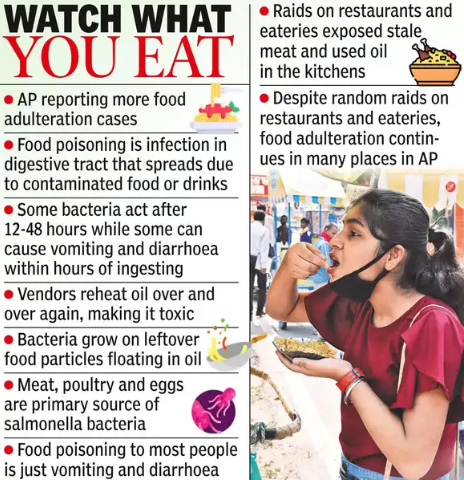Rising Food Adulteration in India
Rising Food Adulteration in India
Syllabus
GS 3: Food Security
Why in the News?
Recent reports from major Indian cities exposed rampant food adulteration in items like milk and paneer, raising public health concerns amid alarming NFHS-5 malnutrition statistics among children under five.
Introduction
- Food is more than nourishment, it shapes our culture, society, and policies.
- However, in India, the focus on nutritional needs is often sidelined by political and social interests.
- Despite alarming data on malnutrition and rampant adulteration, public health concerns remain ignored.
- This crisis demands immediate awareness and action.
Social and Political Dimensions of Food
Food as a Cultural and Political Tool
- In India, food-related decisions are often driven by socio-political factors.
- Whether it’s mid-day meals in schools or state-sponsored events, decisions about food typically reflect social constructs and political interests rather than scientific nutritional requirements.
Neglect of Health Considerations
- Health is rarely the priority in food policymaking.
- Instead of focusing on improving the nation’s nutrition, many policies serve political narratives, sidelining the nutritional value of the food served.
Alarming NFHS-5 Data on Child Malnutrition
Key Statistics from NFHS-5 (2019-21)
- The National Family Health Survey-5 reveals troubling figures for children under five:
- Stunting:5%
- Wasting: 3%
- Underweight:1%
Implications of These Numbers
- These percentages signify widespread nutritional deficiency among children.
- Stunting reflects chronic undernutrition, wasting shows acute malnutrition, and being underweight indicates a combination of both.
- Such conditions have long-term impacts on cognitive development, immunity, and overall health.
Lack of Focus on Nutrition and Quality
Policy Blind Spots
- Despite clear data showing nutritional deficiencies, nutrition remains a low priority in national health discourse and policy implementation.
- This negligence is mirrored in the widespread acceptance of food adulteration.
Public Apathy Toward Food Quality
- The lack of mass outrage over food adulteration is deeply concerning.
- Public health experts argue that poor awareness and lax enforcement of food safety standards contribute to this indifference.
Food Adulteration: A Growing Concern
Historical Context of Milk Adulteration
- Adulteration of milk has long been an issue in India.
- As far back as the 1990s, concerns were raised about unsafe milk consumption.
2011 National Milk Survey Findings
- According to the National Survey on Milk Adulteration (2011):
- 70% of milk samples tested failed to meet food safety standards.
- Common adulterants included water, salt, glucose, and even detergents.
Current Status in 2025
- More than a decade later, adulterated milk is still a problem.
- The failure to significantly reduce such practices shows the lack of strong regulation and accountability mechanisms.
Adulteration in Other Everyday Foods
Fake Paneer Scandal
- Cities like Delhi, Mumbai, and Noida have seen the rise of fake paneer in markets. Adulterants include:
- Starch
- Detergents
- Synthetic milk
- Acetic acid
Toxic Watermelons and Spices
- Investigative reports have also shown adulteration in fruits like watermelon and spices.
- Chemicals used to enhance colour or preserve shelf life pose serious health risks.
Health Risks from Adulterated Foods
- Eating adulterated items can cause:
- Food poisoning
- Long-term organ damage
- Allergic reactions
- In extreme cases, death
India’s Dual Health Burden: Communicable and Non-Communicable Diseases
Communicable Diseases Still Prevalent
- Despite global progress, diseases like diarrhea, typhoid, and cholera still affect large populations in India—often worsened by consumption of contaminated or adulterated food.
Non-Communicable Diseases (NCDs) on the Rise
- India now faces a growing crisis of lifestyle diseases, especially diabetes, due to poor eating habits and low-quality food.
India as the Diabetes Capital
- Around 77 million adults suffer from diabetes in India.
- This makes India one of the countries with the highest number of diabetics in the world.
Link Between Food and Rising Diabetes Cases
Study by ICMR and Madras Diabetes Research Foundation
- A collaborative study highlighted that food habits are directly linked to the rise in diabetes.
- Regular consumption of ultra-processed, fried, and adulterated food items contributes significantly to the burden.
Specific Risk Factors
- Excessive use of low-grade cooking oils
- High consumption of deep-fried snacks
- Lack of awareness about balanced diets
Adulteration of Edible Oils: A Serious Health Hazard
Rampant Adulteration in Mustard Oil
- Adulterants found include:
- Rice bran oil
- Argemone oil
- Artificial allyl isothiocyanate
Health Impacts
- Consumption of such adulterated oils can lead to:
- High blood pressure
- Heart disease
- Liver and kidney damage
- Neurological disorders
Why Is Oil Adulteration So Prevalent?
- Because edible oils are high in demand and relatively expensive, adulterators profit by mixing in cheaper, harmful substances.
Weak Regulatory Framework and Public Unawareness
Ineffective Implementation of Food Safety Laws
- Though India has the Food Safety and Standards Authority of India (FSSAI), poor enforcement and lack of routine inspections weaken its effectiveness.
Limited Awareness Among Consumers
- Most consumers remain unaware of how to check for adulteration.
- There’s also limited access to affordable food testing kits.
Need for Public Campaigns
- Public awareness campaigns on food safety, testing techniques, and the long-term health effects of adulterated food are urgently required.
Recommendations and Way Forward
Strengthen Regulation and Monitoring
- Regular checks on food producers and vendors
- Strict penalties for violators
- Mandatory training for food handlers
Improve Nutrition-Centric Policies
- Policies must prioritize nutritional science over political or social considerations.
- Every government food program must meet minimum health standards.
Encourage Citizen Participation
- People should be encouraged to report adulteration and participate in local food quality drives.
Support Scientific Research and Innovation
- Investment in low-cost, accurate food testing technologies can empower consumers and regulators alike.
Conclusion
India’s food crisis isn’t just about hunger, it’s about what we eat and how safely we eat it. Tackling adulteration and prioritizing nutrition are essential to building a healthier, disease-free population and nation.
Source
Indian Express
Mains Practice Question
Discuss the role of the state in ensuring food safety and nutrition in India. How far have government schemes succeeded in addressing these challenges?




